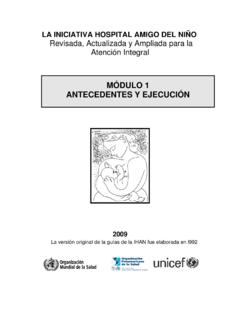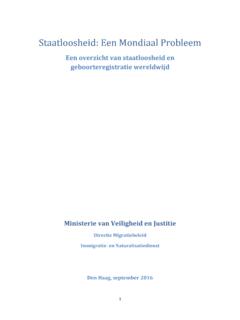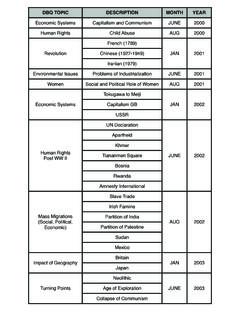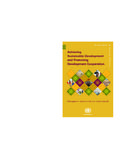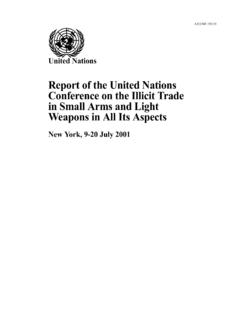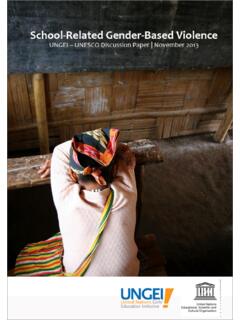Transcription of A statistical reference containing data through 2013
1 IMMUNIZATION SUMMARYA statistical reference containingdata through 2013CD-ROMinside(The 2014 Edition)DISCLAIMER: The data in thisedition supersede all historicaldata previously published byUNICEF and WHO. iIMMUNIZATION SUMMARYA statistical reference containingdata through 2013ii Indicative prices ..viii Trends: Regional Maps: Global Notes on indicators and and and .. and African , Democratic Republic of Rica ..42C te d Republic .. Salvador ..54 Equatorial (Islamic Republic of) .. , Democratic People s Republic , Republic People s Democratic Islands .. (Federated States of) .. iiiGlossary of , the State ..134 Papua New .. Kitts and Saint Vincent and the Tome and Saudi Arab , United Republic former Yugoslav Republic of and Arab , Bolivarian Republic INTRODUCTIONT racking, evaluating and sharing information provides a vital tool for understanding immunization coverage.
2 Statistics on levels and trends are used to monitor the performance of services at local, national and international levels. They guide campaigns to eradicate polio, control measles and eliminate neonatal tetanus. They identify areas of weak system performance and reveal areas where focused attention and extra resources may be required. And, when deciding whether to introduce a vaccine, immunization levels and trends are one important numbers for a single vaccine can provide vital information for national and global action. Coverage levels for the diphtheria and tetanus toxoid with pertussis containing vaccine (DTP), for example, are considered to be good indicators of health system performance. In addition, some funding agencies, such as the GAVI Alliance, often consider immunization coverage levels when reviewing applications for financial and technical support, although coverage estimates alone are insufficient to constitute a sole criterion for determining whether a national immunization programme has achieved certain performance reference book, jointly produced by the United Nations Children s Fund (UNICEF) and the World Health Organization (WHO), presents detailed statistics on the performance of national and district-level immunization systems in 195 countries and territories.
3 It provides an overview of key aspects, including: Basic indicators from WHO and UNICEF, the United Nations Population Division and the World Bank for each country or territory. The latest prevalence of home-based vaccination records. Trends in national and territorial coverage for ten major antigens. v District-level performance in achieving coverage with DTP and measles containing vaccines. The most current immunization schedule reported by each country or copy of the most recent data collection form along with electronic copies of the book, background documentation, and data can be downloaded from UNICEF s statistical data web site at of the background documents and data can also be downloaded from the WHO website at viiANNUAL UPDATES viii Vaccine(doses per vial)BCGBCG-20 DTDT-10 DTPDTP-10 DTPHepHibDTP-HepB-Hib-1 (Liquid) (GAVI)DTP-HepB-Hib-1 (Liquid) (non GAVI)DTP-HepB+Hib-2 (Liophylized) (GAVI)DTP-HepB+Hib-2 (Liophylized) (non-GAVI)DTP-HepB-Hib-10 (Liquid) (GAVI)DTP-HepB-Hib-10 (Liquid) (non GAVI)DTPHibDTP+Hib-1 (Liophylized) (non-GAVI)DTP-Hib-10 (Liquid) (GAVI/non-GAVI)DTP+Hib-10 (Liophylized) (GAVI)DTP+Hib-10 (Liophylized) (non GAVI)DTP-Hib-10 (Liquid) (non GAVI)HepBHepB-1 HepB-10 HibHib-1 (Liquid) (non-GAVI)Hib-1 (Liophylized)Hib-10 (Liquid)HPVHPV2-2 (GAVI)HPV4-1 (GAVI)
4 InfluenzaInfluenza-1 Influenza-10 MCVMea-10 MeningitisMeningitis A Conj-10 Meningitis AC PS-10 Meningitis ACYW PS-10 MMRMMR-1 (L-Zagreb strain)MMRx-1 (Urabe strain)MMR-2 (Jeryl Lyn)MMR-5 (L-Zagreb strain)MMR-10 (Urabe strain)MMR-10 (L-Zagreb strain)MRMR-10 IPVIPV-1bOPVbOPV-20mOPVmOPV1-20tOPVtOPV- 10tOPV-20 PneumococcalPCV13-1 (GAVI)PCV10-2 (GAVI)RabiesRabies-1 RotavirusRV1-1 (GAVI)*RV5-1 (GAVI)TdTd-10 TTTT-10TT-20 Yellow feverYF-5YF-10 (GAVI)YF-10 (non-GAVI)YF-20 Table 1: Indicative budget prices for major antigens, 2014 The prices listed in the table below are subject to change. UNICEF Supply Division provides this information for preliminary budget planning only. Full names of these vaccines appear in the Glossary of Acronyms, p. 197.* The price of RV1-1 vaccines contracted with supplier is EUR per dose. Therefore, the price in US$ will fluctuate throughout the year. The price indicated in this table is based on the UN rate of exchange as of 1 May 2013. ixRecommended budget price, 2014 (US$ per vial) (US$ per dose) availablenot availablenot availablenot availablenot availablenot availablenot availablenot availablenot availablenot availablenot availablenot availablenot availablenot availablenot availablenot availablenot Table 2: Indicative budget price for immunization devices, 2014 These prices are subject to change.
5 UNICEF Supply Division provides this information for preliminary budget planning (box of 100, unless otherwise stated)Recommended budget price, 2014 (US$ per box)BCG autodisable syringe, autodisable syringe, syringe, syringe, 2 ml, with prevention feature syringe, 2 ml, with fixed needle *Re-use prevention feature syringe with SIP, 3 ml, with fixed *Reconstitution syringe, 5 ml, with prevention feature syringe, 5 ml, with fixed needle prevention feature syringe with SIP, 5 ml, with fixed syringe, 10 ml, with needle prevention feature syringe, 10 ml, with fixed box, 5 l (box of 25) * FCA price. xiTRENDS: REGIONAL PROGRESS TOWARDS MDG4, 1980 - 2013 Note: The list of countries and territories in MDG regions appears online at the United Nations Statistics Division website Millennium Development Goals Indicators < > xii MCV1 Coverage20132012201120102009200820072006 2005200420032002200120001999199819971996 19951994199319921991199019851980 Global8483838483828080767775737373727271 737372706969734816 MDG regionsCaucasus and Central countries9394939292949494939393939292919 090908886838283848063 Eastern Asia999999999997949387878686868484828283 807682879298871 Latin America929695949596959694959695969593928 9858783838481776143 Caribbean7979787878777676767777787877757 675757473716868645120 Northern Africa9695969695929696949393939493929392 928989888786846621 Oceania737164605958636966636665616767655 640524743737270364 South-eastern Asia898885848484828585858179818283838383 767675737270260 Southern Asia767575767576727365706460616261595865 70676155495792 Sub-Saharan Africa7470727473686664615957545353505253 54545451505356326 Western
6 Asia838387878887848384817982868685847876 7374747475795517 UNICEF regionsCentral and Eastern Europe and CIS9695959494969696959291929493919089858 281838283858972 East Asia and Pacific959593939392899086868483848383828 283787679838689691 Eastern and Southern Africa7981807977737369666665656361616466 66646660585962439 Industrialised Countries9394939392939393929292919191908 990908886828182837152 Latin America and the Caribbean9295949394959494939495949594929 189848683828380766042 Middle East and North Africa8988919190888886868585848586858583 848180808079805520 South Asia757474757475717264696359606059585764 69665953475660 West and Central Africa6860646769625958565248444344394041 41454441424751244 WHO regionsAfrican 7471737474696764625958555453515354555556 52515458356 American92949493939493949394949394939291 89868785838382806851 Eastern Mediterranean787780817778787878767373737 2717068696668676766674715 European95959493949595949392919192918988 88868483838282837655 South East Asian78797877777773756672676264656463626 972696357515960 Western Pacific979796969795929288888686868585848 484817780858994794 xiiiDTP3 coverage20132012201120102009200820072006 2005200420032002200120001999199819971996 19951994199319921991199019851980 Global8483838484838080787775737373727272 727373707072765020 MDG regionsCaucasus and Central countries9596949495969696969696959593949 291939091878686838269 Eastern Asia999999999997939387878686868584838383 808588919496781 Latin America899594949493939494939492919290878 4838481797878685637 Caribbean8182818279808079797671777373737 170687071706868685032 Northern Africa9795969797979797969594949695939190 918986858481877328 Oceania726967636759666766677266626566655 4636867656673744537 South-eastern Asia858885858685828281828176818180828179 7776747374753816 Southern Asia767676777574697372716763636363636465 696560575968207 Sub-Saharan Africa7468697273706864625956535252494949 50525349494856295 Western
7 Asia838388898987858384847781868582827876 7479787776865628 UNICEF regionsCentral and Eastern Europe and CIS9595929294959695959287919493919089858 285758079758175 East Asia and Pacific939594939492898985858482848383828 281798283858890666 Eastern and Southern Africa7979797876747370696766646360596366 666766615758634110 Industrialised Countries9697969696969696969696959493939 291949191878889898062 Latin America and the Caribbean8994939394929293939292919091898 683828380797778685537 Middle East and North Africa9089929291919089888886858787858382 838178818079855724 South Asia757575767473687271706662626261626264 686459555767195 West and Central Africa6957576570656158555146424042393732 34394236403749191 WHO regionsAfrican75686972747068656360575452 5249515051545550505057325 American90949494949393949493939291929189 86858684817980746450 Eastern Mediterranean828184868279828181777675757 3716967666961626465714618 European96969494959696959594929394939392 91898788818584807863 South East Asian77777777777669737172686465666566676 9717064606170207 Western Pacific969796969795929288888785868584838 383808486899294748 MAPS: GLOBAL INDICATORSxvi Map 1: Immunization coverage with measles- containing vaccines in infants, 2013 Source: WHO/UNICEF coverage estimates, 1980-2013, July 2014 The boundaries and names shown and the designations used on this map do not imply the expression of any opinion whatsoever on the part of UNICEF or the World Health Organization concerning the legal status of any country, territory, city or area or of its authorities, or concerning the delimitation of its frontiers or boundaries.
8 Dotted lines on maps represent approximate border lines for which there may not yet be full agreement.<50% (4 countries or 2%)50-79% (33 countries or 17%)80-89% (28 countries or 14%)>= 90% (129 countries or 66%)Not availableNot applicable xviiMap 2: Developing and transition countries and territories* with all districts achieving at least 80% DTP3 coverage, 2013 Source: WHO/UNICEF Joint Reporting Form, 2013, July 2014* 156 developing countries and economies in transition per UN World Economic & Social Survey, 2014 boundaries and names shown and the designations used on this map do not imply the expression of any opinion whatsoever on the part of UNICEF or the World Health Organization concerning the legal status of any country, territory, city or area or of its authorities, or concerning the delimitation of its frontiers or boundaries. Dotted lines on maps represent approximate border lines for which there may not yet be full (47 countries or 30%)No (90 countries or 58%)No data (19 countries or 12%) (DTP3 estimated coverage for 2013: 14 countries 90%; 5 countries<90%) Developed countries (38 countries)Not availableNot applicablexviii Map 3: Countries by percentage of districts achieving at least 80% DTP3 coverage, 2013 Source: WHO/UNICEF Joint Reporting Form, 2013, July 2014 The boundaries and names shown and the designations used on this map do not imply the expression of any opinion whatsoever on the part of UNICEF or the World Health Organization concerning the legal status of any country, territory, city or area or of its authorities, or concerning the delimitation of its frontiers or boundaries.
9 Dotted lines on maps represent approximate border lines for which there may not yet be full agreement.< 50% (20 countries or 10%)50_79 % (33 countries or 17%)80_99 % (41 countries or 21%)All districts (58 countries or 30%)WHO UNICEF estimates is <90% & differ from Country administrative coverage or administrative data not available (35 countries ) Not available / No district data reported (42 countries or 22%) Not applicableNOTES ON INDICATORS AND DATAxx Basic indicatorsBirths The number of children born each infants The number of children who have survived beyond their first year of both births and surviving infants, figures are rounded to the nearest thousand. Where populations are small and birth rates are low, the figure shown is 0 . In countries or territories where the numbers of births and surviving infants are very close, rounding to the nearest thousand may cause the figures to appear equal. In places where the birth rate is declining, it is possible for the number of surviving infants to exceed births because the former were born in the previous mortality rate The probability of dying between birth and exactly one year of age.
10 The infant mortality rate is expressed as the number of infant deaths per 1,000 live mortality rate The probability of dying between birth and exactly five years of age. The under-five mortality rate is expressed as the number of deaths of children under age five per 1,000 live national income per capita (PPP, US) Gross national income (GNI) is the sum of value added by all resident producers, plus any product taxes (less subsidies) not included in the valuation of output, plus net receipts of primary income (compensation of employees and property income) from abroad. GNI per capita is gross national income divided by mid-year population. GNI per capita in US dollars is converted using the World Bank Atlas method. Purchasing power parity (PPP) is a criterion for an appropriate exchange rate between currencies. It indicates that a representative basket of goods in one country would cost the same as in another country if the currencies are exchanged at that rate.










